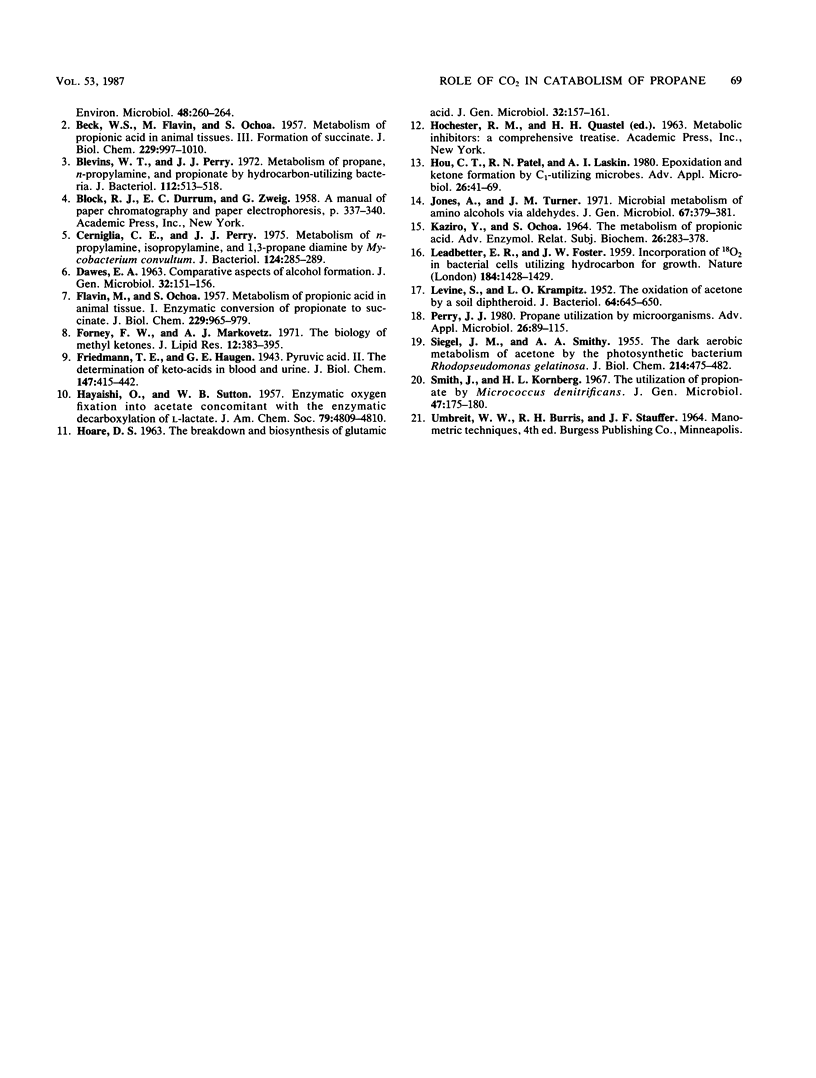Abstract
The catabolism of propane by “Nocardia paraffinicum” (Rhodococcus rhodochrous) has been shown to involve CO2 fixation after its oxidation to propionic acid. “N. paraffinicum” failed to grow on either propane or 1-propanol in the absence of CO2. The rate of propane utilization was directly related to the initial CO2 concentration, and Warburg respirometry suggested that CO2 was required for the catabolism of 1-propanol, propionaldehyde, and propionate but not for 2-propanol. These data also suggested that the predominant pathway for the utilization of propane by “N. paraffinicum” was through 1-propanol. The use of [2-14C]propane and 14CO2 confirmed the catabolism of propane and the fixation of CO2. Through the use of these isotopes and the pyruvate carboxylase inhibitor sodium arsenite, the labeled 2,4-dinitrophenylhydrazine derivative of pyruvate was trapped and isolated via thin-layer chromatography. The trapping of [14C]pyruvate in this manner was considered to be indicative of the presence of the methylmalonyl coenzyme A pathway for CO2 fixation.
Full text
PDF




Selected References
These references are in PubMed. This may not be the complete list of references from this article.
- BECK W. S., FLAVIN M., OCHOA S. Metabolism of propionic acid in animal tissues. III. Formation of succinate. J Biol Chem. 1957 Dec;229(2):997–1010. [PubMed] [Google Scholar]
- Babu J. P., Brown L. R. New type of oxygenase involved in the metabolism of propane and isobutane. Appl Environ Microbiol. 1984 Aug;48(2):260–264. doi: 10.1128/aem.48.2.260-264.1984. [DOI] [PMC free article] [PubMed] [Google Scholar]
- Blevins W. T., Perry J. J. Metabolism of Propane, n-Propylamine, and Propionate by Hydrocarbon-Utilizing Bacteria. J Bacteriol. 1972 Oct;112(1):513–518. doi: 10.1128/jb.112.1.513-518.1972. [DOI] [PMC free article] [PubMed] [Google Scholar]
- Cerniglia C. E., Perry J. J. Metabolism of n-propylamine, isopropylamine, and 1,3-propane diamine by Mycobacterium convolutum. J Bacteriol. 1975 Oct;124(1):285–289. doi: 10.1128/jb.124.1.285-289.1975. [DOI] [PMC free article] [PubMed] [Google Scholar]
- DAWES E. A. COMPARATIVE ASPECTS OF ALCOHOL FORMATION. J Gen Microbiol. 1963 Aug;32:151–155. doi: 10.1099/00221287-32-2-151. [DOI] [PubMed] [Google Scholar]
- FLAVIN M., OCHOA S. Metabolism of propionic acid in animal tissues. I. Enzymatic conversion of propionate to succinate. J Biol Chem. 1957 Dec;229(2):965–979. [PubMed] [Google Scholar]
- Forney F. W., Markovetz A. J. The biology of methyl ketones. J Lipid Res. 1971 Jul;12(4):383–395. [PubMed] [Google Scholar]
- HOARE D. S. THE BREAKDOWN AND BIOSYNTHESIS OF GLUTAMIC ACID. J Gen Microbiol. 1963 Aug;32:157–161. doi: 10.1099/00221287-32-2-157. [DOI] [PubMed] [Google Scholar]
- Jones A., Turner J. M. Microbial metabolism of amino alcohols via aldehydes. J Gen Microbiol. 1971 Aug;67(3):379–381. doi: 10.1099/00221287-67-3-379. [DOI] [PubMed] [Google Scholar]
- KAZIRO Y., OCHOA S. THE METABOLISM OF PROPIONIC ACID. Adv Enzymol Relat Areas Mol Biol. 1964;26:283–378. doi: 10.1002/9780470122716.ch7. [DOI] [PubMed] [Google Scholar]
- LEADBETTER E. R., FOSTER J. W. Incorporation of molecular oxygen in bacterial cells utilizing hydrocarbons for growth. Nature. 1959 Oct 31;184(Suppl 18):1428–1429. doi: 10.1038/1841428a0. [DOI] [PubMed] [Google Scholar]
- LEVINE S., KRAMPITZ L. O. The oxidation of acetone by a soil diphtheroid. J Bacteriol. 1952 Nov;64(5):645–650. doi: 10.1128/jb.64.5.645-650.1952. [DOI] [PMC free article] [PubMed] [Google Scholar]
- SIEGEL J. M., SMITH A. A. The dark aerobic metabolism of acetone by the photosynthetic bacterium Rhodopseudomonas gelatinosa. J Biol Chem. 1955 May;214(1):475–482. [PubMed] [Google Scholar]
- Smith J., Kornberg H. L. The utilization of propionate by Micrococcus denitrificans. J Gen Microbiol. 1967 May;47(2):175–180. doi: 10.1099/00221287-47-2-175. [DOI] [PubMed] [Google Scholar]


